Wilderness Adventures
Hunting reindeer in the Norwegian wilderness
People have hunted reindeer in Norway for thousands of years. Although we now have modern clothes and equipment, reindeer hunting in the wilderness still poses one of the greatest physical hunting challenges, you can set yourself.
We have been walking for more than an hour. Norwegian Peder Myrset makes it clear that we must follow the tourist path for a few hours more. Then we will turn away from the path, which is the only remnant of civilization out here. The remaining 10 kilometers of the hike towards the main hunting area must be crossed in areas of complete wilderness.
In a flimsy attempt to find protection against the cold wind and the constant rain, the hunter pulls his hood well over his head while mentally preparing for the last part of the trip. Then he gets up and instantly feels the pull of his heavy backpack. This Norwegian reindeer hunting is going to be one of the tougher trips.
Norwegian reindeer are hunted on legs and are dependent on your strength, endurance, and right mental attitude to succeed. These types of hunts are fundamentally all about overcoming Europe's harshest wilderness.

“Suddenly, the hunter comes running back at a neck-breaking speed. He has seen three reindeers, all bucks.”
//Meat hunting//

In Europe, reindeer hunting can be arranged in Norway, Iceland and Finland. The reindeer hunting in Norway is controlled by a licensing system, which is based on annual counts, issues a number of licenses on females, calves, young bucks and so-called free animals. The licenses for a free animal can be used on all animals. However, considering the price for this type of license, the so-called free animal licenses will predominantly be used for taking mature trophy bucks.
Reindeer hunting in Norway is a very ethical hunt, which places great emphasis on meat harvesting. To take long shots or shots against game that stand too close to one another or are in movement is considered a violation of the law. Expect the authorities to check licenses and hunting ethical behavior throughout the season.
Under a tarpaulin
It is still raining when we reach the cave that will provide shelter for us for the night. The cave, which Peder has used as a camp for many years, is not pure luxury – far from it – but in this harsh terrain, it is certainly usable.
We all have moist feet after the long hike in a constantly wet environment, so it is with a bit of annoyance that we see that it drips a little from small crevices in the rock above us. It may well be a damp night. We all soon forget our worries when Peder says: “It's time to put out the nets in one of the lakes.” We have not brought much food. Fish must constitute the major part of the diet on this trip.
Down towards the lake, we must jump from rock to rock. Peder is in front, the hunter is just behind him. While they draw trout nets across the lake, the hunter enjoys the change of the weather, which is slowly but surely crawling in over the gray massifs with scattered snow. The snow at this altitude never melts away completely, as the summer is short and cold. Peder tells the hunter how to fasten the net before they return to the primitive accommodation where they eat a few slices of bread with sausage accompanied by the purest wilderness water.
For the first time in his life, the hunter tries to sleep wrapped in a tarpaulin. It’s a way of sleeping that is quite normal for Peder when he is hunting here. The experienced reindeer hunter has come here for more than 65 years, where he has caught numerous trout, collected many hundreds of kilos of berries and harvested tons of reindeer meat – and carried everything out on his back.
The tarpaulin works fine as a protection against the rock cave's damp floor and the sporadic dripping from the ceiling. Everything works as it should, and we all fall asleep in a matter of minutes.
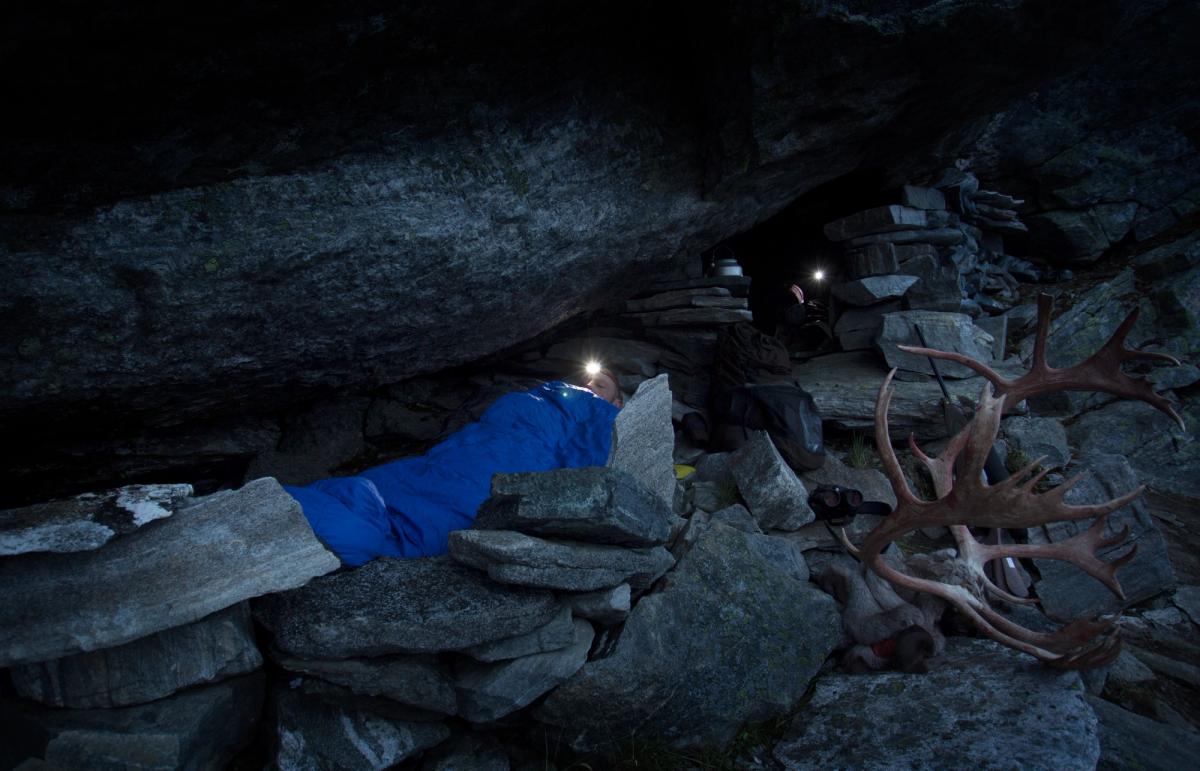
No breakfast
The hunter is the first to get up. The weather has cleared up just fine and he takes a morning walk on the low mountainside behind the camp while Peder is boiling coffee water over the small gas burner. The water in the boiler reaches a coffee friendly heating degree that makes the kettle lid rattle when the hunter comes running back at a neck-breaking speed. He has seen three reindeers, all bucks, one without velvet on the antlers. It is exactly such a buck he is looking for and has the license to take.
The older bucks shed the velvet off the antlers first, and they usually do it right around the 1st of September, only a week away. The hunter is therefore not only lucky to have found a mature buck, he is lucky that it has shed its velvet this early in the season, too.
Although you can see far up here in the mountains, the reindeer are certainly not easy to spot. Their coat is perfectly tailored to act as camouflage in the terrain. Actually, it’s the impressive, bright and bloody antlers that are most visible and reveal to us that the animals are somewhat below the stone cave.
The hunters can’t eat breakfast before going out, that’s obvious, as the fishing nets (with breakfast) are still in the water. The nets will have stay there until after the hunt, because the reindeer are located near the lake in which the nets are put out. Although the coffee water has just started to boil, Peder shuts off the burner. Then he starts preparing for the hunt while looking at the map and checking the wind direction.
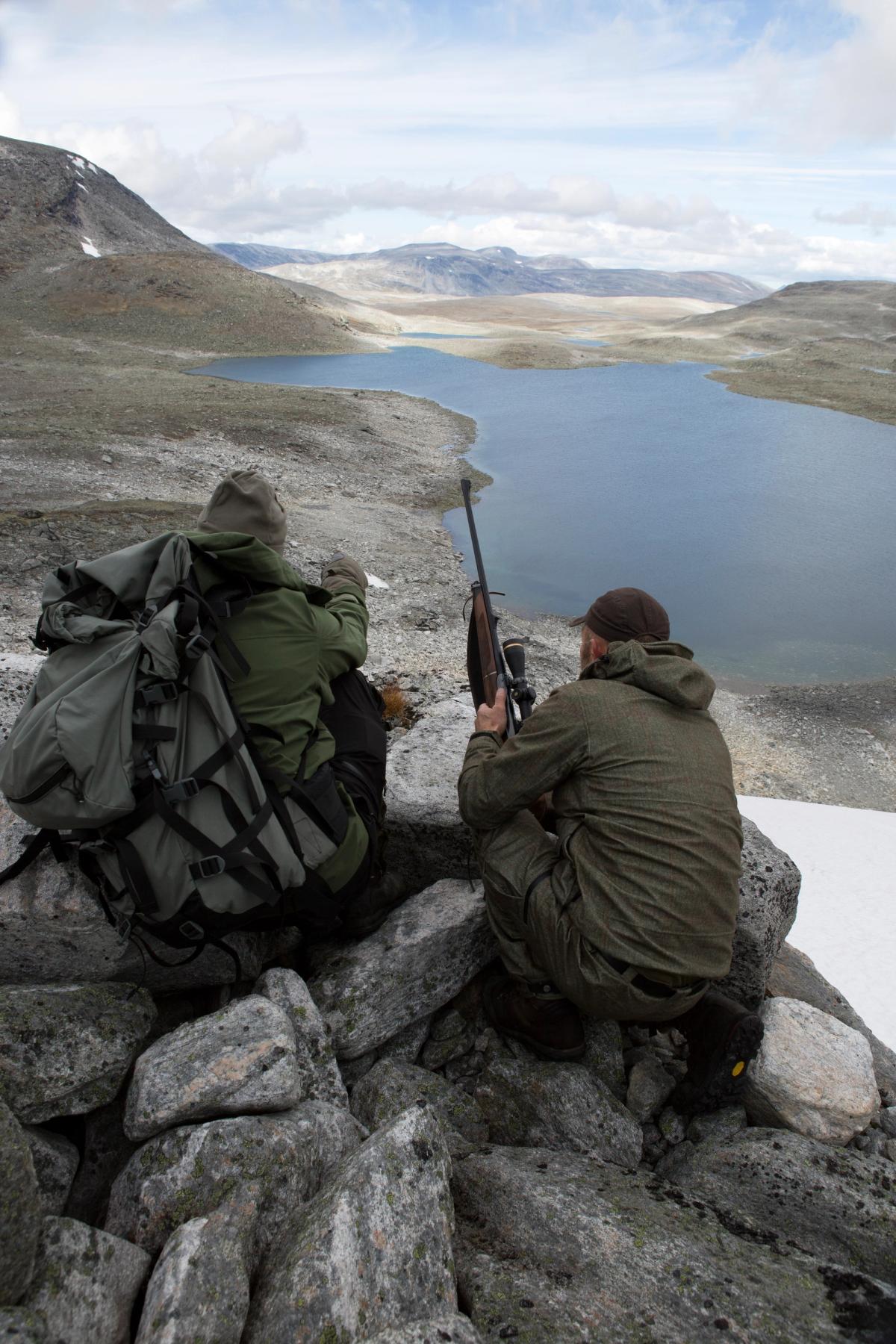


Moving toward the reindeer
This hunting area is called Snøhetta. It is divided between three municipalities covering an area of over 3.300 square kilometers. In 2015, there were issued 1.680 licenses for the area, of which 774 were used. With the hunting success rate for this area being less than 50 percent, the hunter must not only hope that the weather lasts, he will also have to rely on Peder’s more than 50 years of experience in stalking reindeer on the mountain.
In cover from the reindeer, we are rapidly moving down through the rocky landscape, crossing a glacier-like area of snow. The next half kilometers we jump from rock to rock before crossing the river and from there the steep climb begins that will bring us into position, overlooking the animals.
We approach the animals with the sun in our back, and in a few hours, we have come as far as the terrain and the sharp senses of the reindeer will allow us. We are, however, not close enough to take a shot, so we sit and wait for half an hour. So do the reindeer. It is a test in patience and since success seems far away, we decide to walk back to the camp for a cup of coffee and from that position watch the movements of the reindeer.

The final approach
40 minutes later, we are back at the cave. Peter begins to boil water for coffee, and it has just reached the boiling point when the animals rise again. Peder looks questioningly at the hunter. Coffee or hunting? The answer is obvious.
On empty stomachs, we try to approach the animals from the other side. After another four hours of hunting, we get to within 200 meters of the largest of the three bucks. The hunter takes aim, shoots, and after a short sprint, the buck falls over.
Altogether, the hunt has lasted for more than seven hours, from the time the animals were spotted until the hunt ended. The only thing left to do now is to place the meat under a heap of stones of some size to prevent a wolverine from getting to it. Lastly, we collect the fishing nets, heat up the coffee water and get some much-needed food in our empty stomachs.
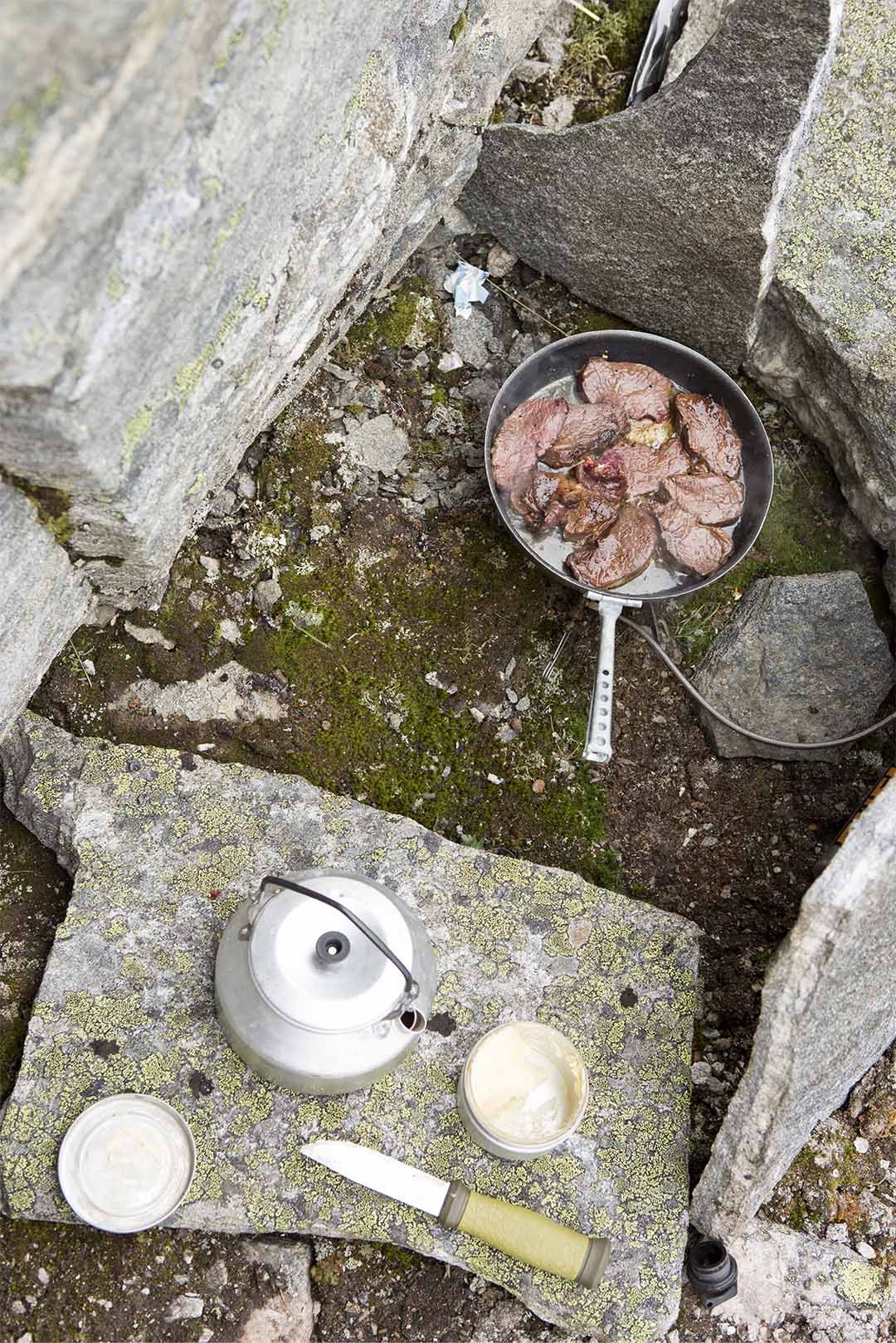
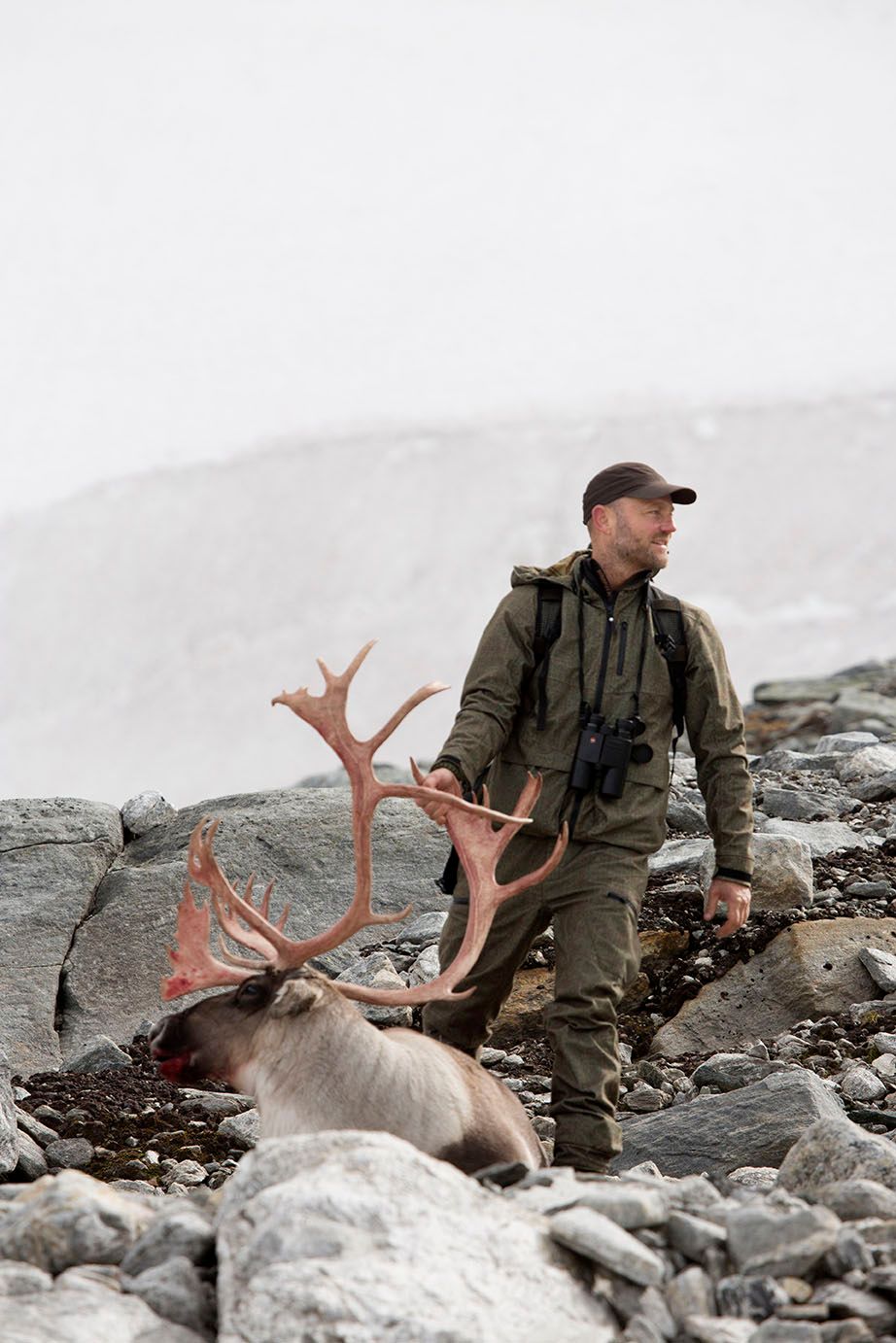
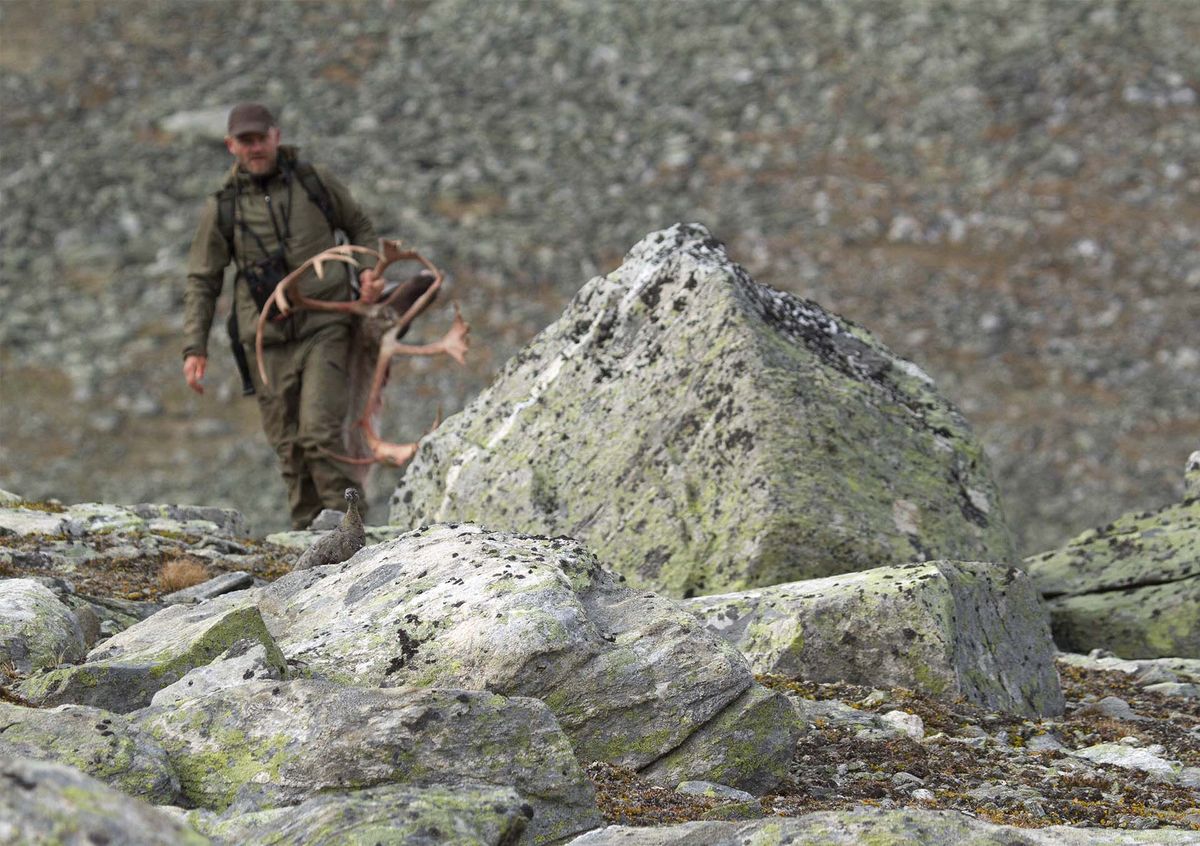
Pain and pleasure
Besides bringing smiles on our faces, the successful hunt has provided us with something to yet. For the first time in the more than 50 years that Peter has fished in the mountains, the fishing nets were tuned out to be empty. The tough Norwegian never brings food with him on his mountain hikes, as he lives from what he can hunt, catch, or collect. If we had not had the reindeer meat by now, we would quite literally be without food.
It has been a tough day; the reindeer meat lies heavily in our stomachs and tiredness comes quickly. Exhausted and with aching muscles, we crawl into our sleeping bags in the small cave. Sleep comes easily.
The next morning, the hunter notices through the small cave opening that it has started to rain again. Sad, but true. After a quick cup of coffee and eating the last two slices of white bread, it is time to go get the meat to the depot. Fortunately, we only have to carry it for a few kilometers further down the mountain. From there Peder will get it out with the use of his Icelandic ponies.
Later, when the hunter and Peder return to camp in wet clothes to pack for the walk home, the hunter feels that the last couple of days of hard work has taken a toll on his body. It has been hard to keep up with Peder, who despite his is nearly 70 years moves through the terrain at a constant speed, without showing any signs of weakness.
While the hunter is struggling to get his backpack onto his back, he sees Peder adjust his backpack straps so that everything is close to his back. The hunter turns around and grabs his reindeer trophy, lift it and place it on his shoulders. When he is done and ready to go, Peder has already commenced the 20 kilometers walk back. In fact, he is already 50 meters a head of the hunter, who knows the next several hours will be a mixture of pain and pleasure – typically for a reindeer hunt!

Hunting reindeer in Norway
It is not possible for foreign hunters to buy licenses to hunt reindeer on the Norwegian State land. On the other hand, you can buy a license from a private landowner, which in some areas can provide access to both the private and governmental mountain areas. A license can cost anywhere from about 500 NOK for a calf up to 40.000 NOK for a license on a free animal in a particularly attractive area. In Snøhetta, a calf license typically costs 1.500 NOK, while a license for a free animal can be acquired for around 5.000 to 8.000 NOK.
If you want to go reindeer hunting in Norway on private land, these are good webpages to visit:
Setesdal/Ryfylke: www.villreinlag.no
Setesdal Austhei: www.savl.no
Forollhogna: www.hognareinen.no
The deadline for applications for licenses may vary, but is typically around May 1st. Read more about reindeer hunting and hunting in general in Norway: www.inatur.no
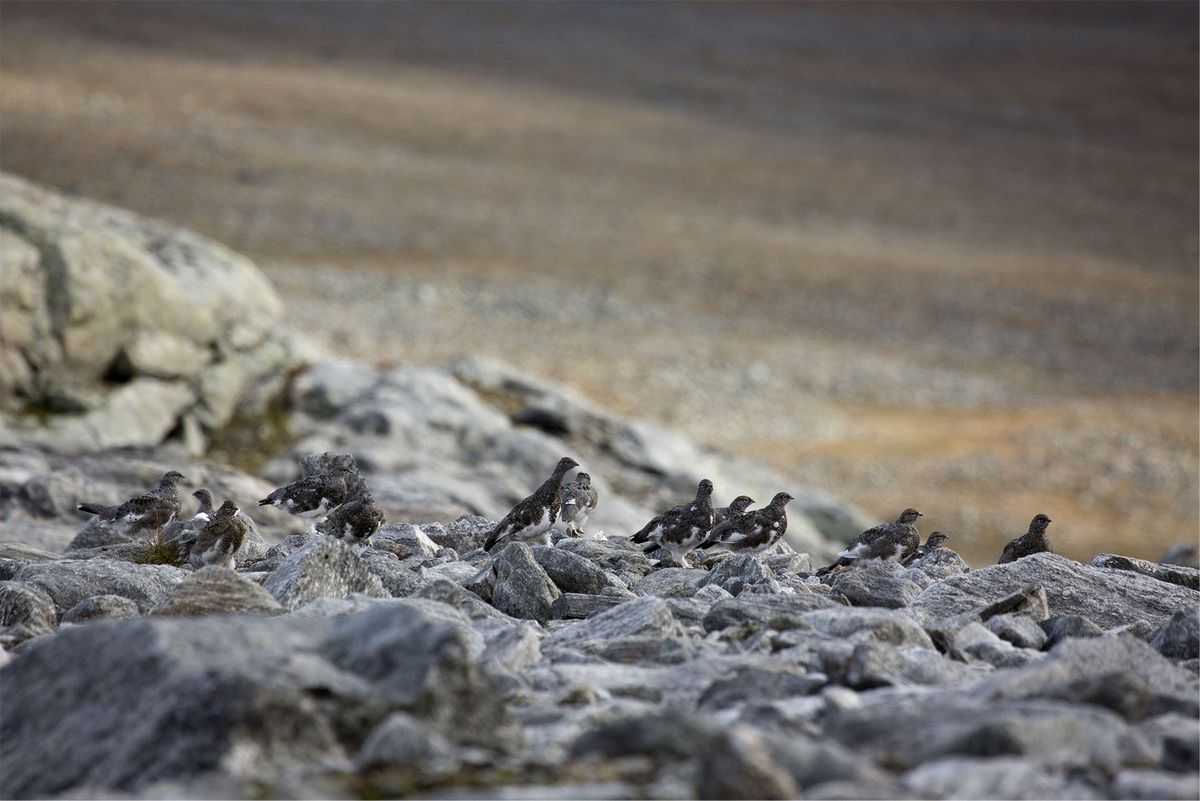
Local knowledge an advantage
We were hunting in an area, which is very far away from civilization. We would never have sought out the place without the help of Peder. If it is the first time you go reindeer hunting in Norway, it is highly recommended that you contact a local experienced hunter who knows the area you are licensed for, so that he or she can help you out. The connection might be done through social media like Facebook.
Success rates
The success rate during reindeer hunting will never be a 100 %. In 2015, 20.860 licenses were given throughout Norway and 6.509 animals were taken. In other words, only 31,2 % of the licenses ended with a successful hunt. You will find the highest success rate in the very popular and more physically accessible Forollhogna area, but this also reflects in the prices. Annually, the area has about 700 licenses and the success rate in 2015 was 83 %.